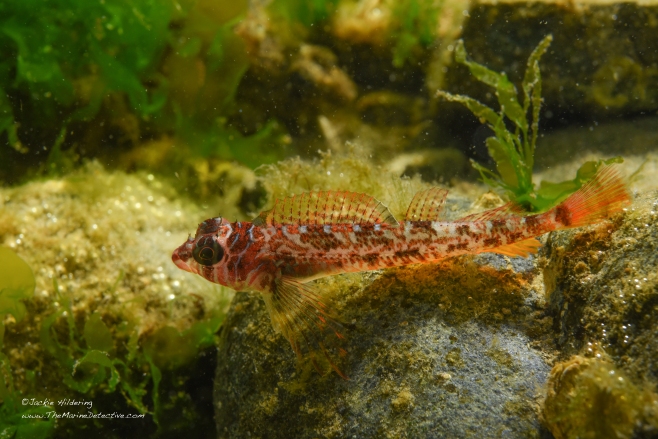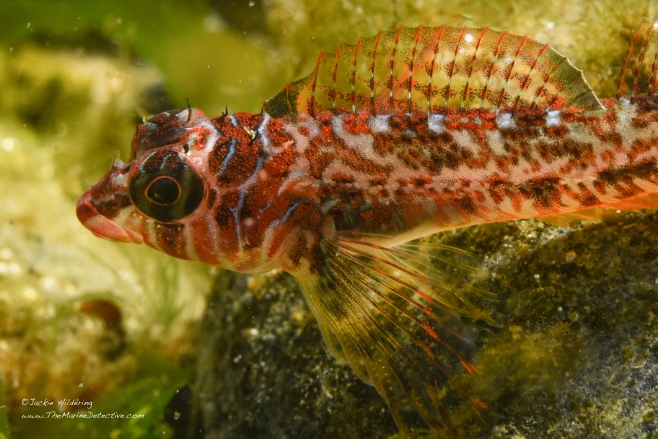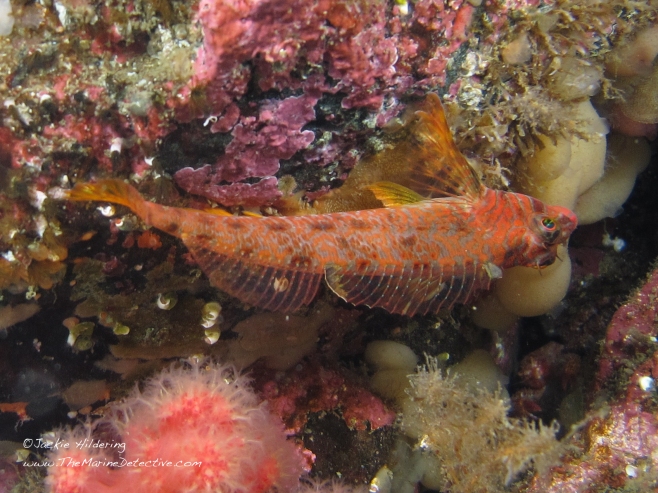Living Gems #2 – Longfin Sculpin
To follow up on yesterday’s blog about Candy-Stripe Shrimp and their association with Crimson Anemones, here’s another ambassador from my last dive who shatters the notion that these waters do not explode with colour and biodiversity.
This little Longfin Sculpin was at only 1 m depth. I saw him/her immediate when I descended and had such good fortune that the fish did not dart away. It’s usually what they do.

Longfin Sculpin = Jordania zonope to 15 cm long. May 20th, 2020 near Telegraph Cove.

May 20th, 2020 near Telegraph Cove.
JUST LOOK at the colour, the patterns, the texture . . . and the gossamer fins.
Here’s another individual from a different dive to give you a sense of the variation in colour and patterns. This colouration and banded pattern often helps them camouflage because so much of the life in these waters is brightly coloured.

June 9, 2019 Hanson Island
BUT Longfin Sculpins are among the local fish species that change colour at night. They darken to match their nocturnal surroundings so they have a better chance of . . . seeing another day.
The photo below shows how extreme this colour change is.

March 5th, 2013 Port Hardy.
This is known as “nocturnal protective colouration” and this adaptation is not unique to species of fishes but is also found in birds, mammals, insects, etc
The males are apparently also darker when courting females and protecting eggs. They are very territorial when egg-guarding.

A Longfin Sculpin in “Spider Man” mode. September 9, 2011 Pearse Island.
Further information from Dr. Milton Love’s Certainly More Than You Want to Know About the Fishes of the Pacific: “Young settle out of the plankton when around 2.3 to 3 cm long and then live a life where they are mostly solitary (other than to mate and egg guard) and rarely swim more than 0.5 m off the bottom. They use their pectoral fins to crawl around and hang on, even able to kind of “Spider Man” it by hanging on to vertical walls, head oriented downward. They are reportedly highly territorial with domains being from 0.3 to 0.5 metres squared / individual) . . . There have been some observations of the species cleaning the mouths of Lingcod, amid their many and very sharp teeth.”
Below, is one of Jan Kocian’s amazing captures (and cartoons) of a Longfin Sculpins serving as a cleaner fish to a Lingcod.

Scalyhead Sculpins have also been documented by as cleaner fish to Lingcod.
More often than eating snacks found on Lingcod 🙂 , Longfin Sculpins’ diet is “benthic arthropods” which include crabs, hermit crabs, isopods and shrimp. This is the diet of many sculpin species but one study found that Longfin Sculpins take bites out of their prey where other species like Scalyhead Sculpins swallow them whole.
Sources:
Demetropoulos CL, Braithwaite LF, Maurer BA, Whiting D. 1990. Foraging and dietary strategies of two sublittoral cottids, Jordania zonope and Artedius harringtoni. J Fish Biol 37:19–32.
T J Buser, D L Finnegan, A P Summers, M A Kolmann, Have Niche, Will Travel. New Means of Linking Diet and Ecomorphology Reveals Niche Conservatism in Freshwater Cottoid Fishes, Integrative Organismal Biology, Volume 1, Issue 1, 2019, obz023.

One Response to “Living Gems #2 – Longfin Sculpin”
As always, your photos are stunning and the stories are a joy to read. Thank you for sharing the mysterious life under the sea.